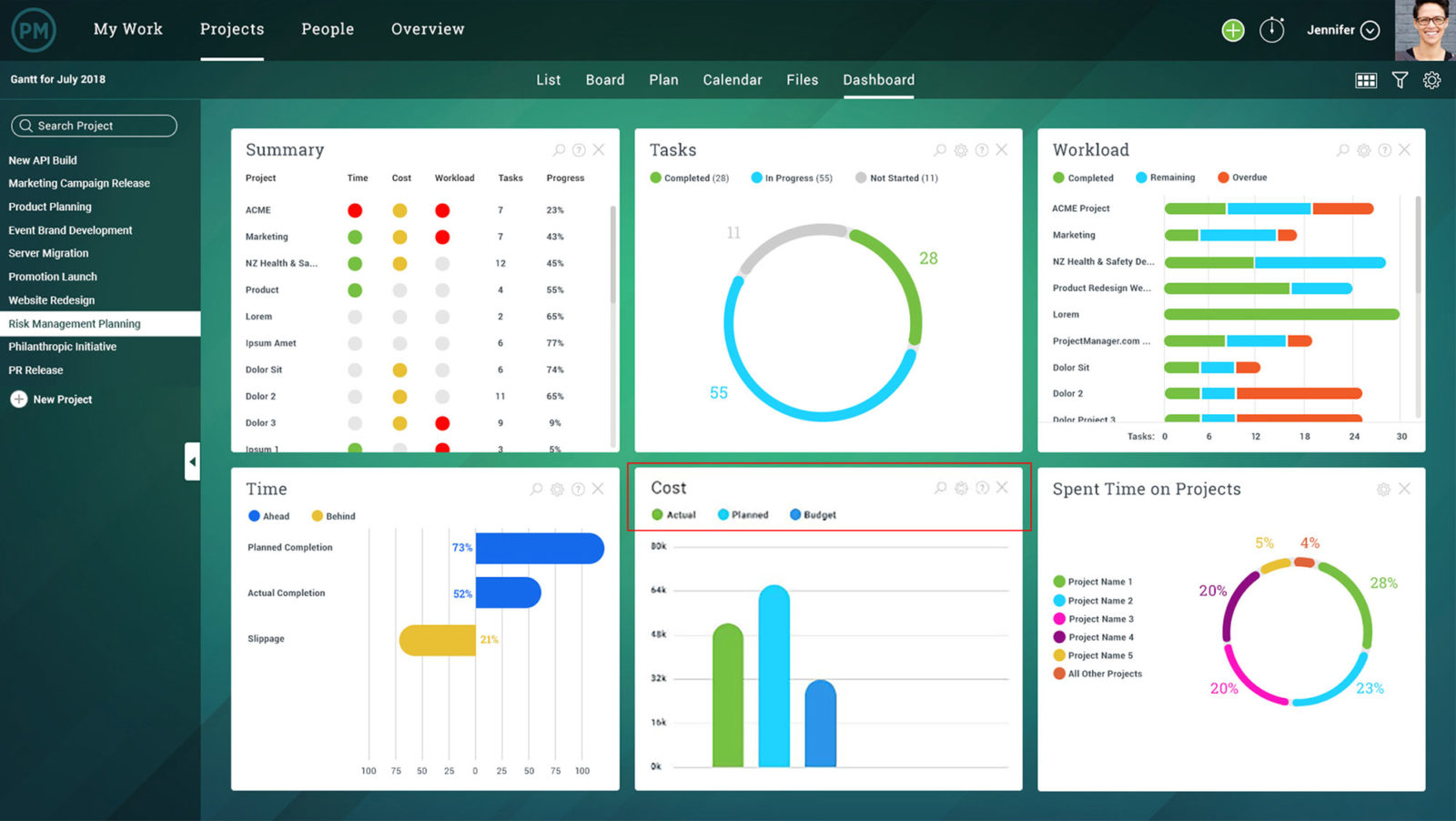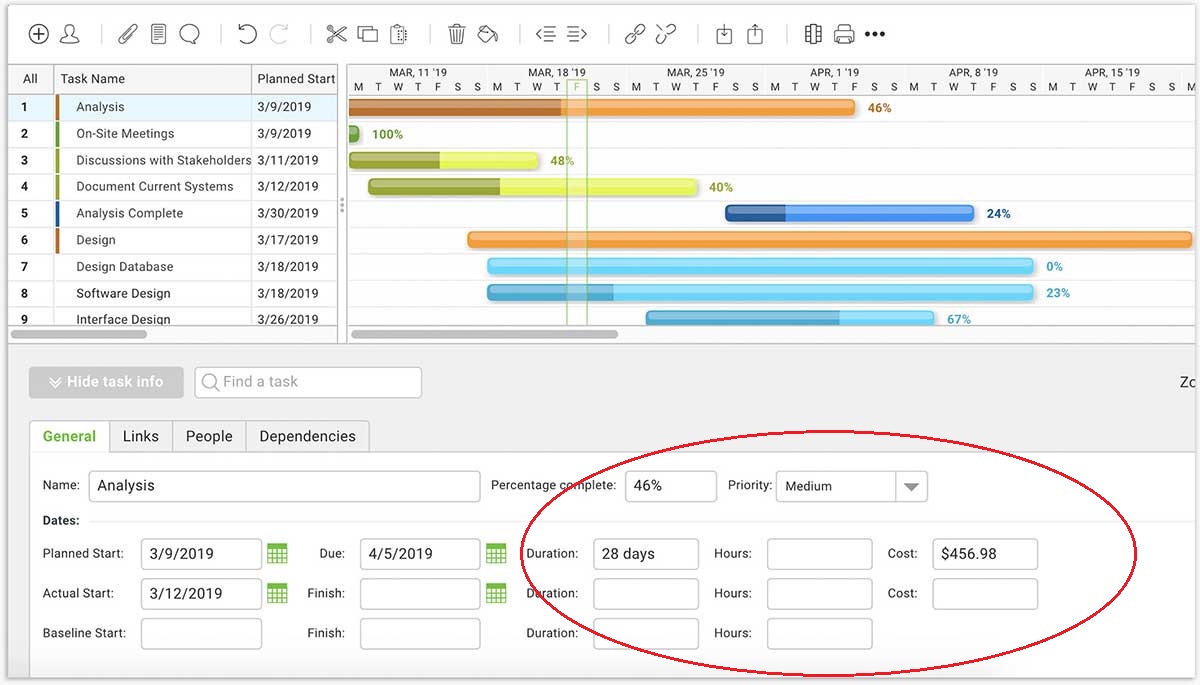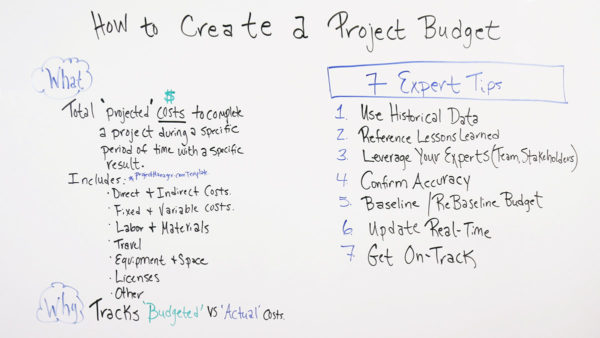If you don’t have the funds, you’re not going to complete the project successfully. That’s why planning out your project budget is so important: it’s the lifeblood of the project. Follow these steps to secure the funds necessary to support the project through every phase. But first, we need to define what a project budget is.
What Is a Project Budget?
A project budget is the total projected costs needed to complete a project over a defined period of time. It’s used to estimate what the costs of the project will be for every phase of the project.
The project budget will include such things as labor costs, material procurement costs and operating costs. But it’s not a static document. Your project budget will be reviewed and revived throughout the project, hopefully with the help of a project budgeting software.
Why You Need a Project Budget
The obvious answer is that projects cost money. But it’s more nuanced than that. For example, the budget is the engine that drives your project’s funding. It communicates to stakeholders how much money is needed and when it’s needed.
But it’s not only a means to get things that your project requires. Yes, you need to pay teams, buy or rent equipment and materials, but that’s only half the story.
The other part of the importance of a project budget is that it’s an instrument to control project costs. The budget is your plan, which acts as a baseline to measure your performance as you collect the actual costs once the project has been started.
Related: Cost Estimation for Projects: How to Estimate Accurately
Creating a Project Budget
As noted above, there are many components necessary to build a budget, including direct and indirect costs, fixed and variable costs, labor and materials, travel, equipment and space, licenses and whatever else may impact your project expenses.
To meet all the financial needs of your project, a project budget must be created thoroughly, not missing any aspect that requires funding. To do this, we’ve outlined seven essential steps towards creating and managing your project budget:
1. Use Historical Data
Your project is likely not the first to try and accomplish a specific objective or goal. Looking back at similar projects and their budgets is a great way to get a headstart on building your budget.
2. Reference Lessons Learned
To further elaborate on historical data, you can learn from their successes and mistakes. It provides a clear path that leads to more accurate estimates. You can even learn about how they responded to changes and kept their budget under control.
3. Leverage Your Experts
Another resource to build a project budget is to tap those who have experience and knowledge—be they mentors, other project managers or experts in the field. Reaching out to those who have created budgets can help you stay on track and avoid unnecessary pitfalls.
4. Confirm Accuracy
Once you have your budget, you’re not done. You want to take a look at it and make sure your figures are accurate. During the project is not the time to find a typo. You can also seek those experts and other project team members to check the budget and make sure it’s right.
5. Baseline and Re-Baseline the Budget
Your project budget is the baseline by which you’ll measure you project’s progress once it has started. It is a tool to gauge the variance of the project. But, as stated above, you’ll want to re-baseline as changes occur in your project. Once the change control board approves any change you need to re-baseline.
6. Update in Real Time
Speaking of changes, the sooner you know about them, the better. If your software isn’t cloud-based and updating as soon as your team changes their status, then you’re wasting valuable and expensive time.
7. Get on Track
The importance of having a project management software that tracks in real time, like ProjectManager.com, is that it gives you the information you need to get back on track sooner rather than later. Things change and projects go off track all the time. It’s the projects that get back on track faster that are successful.
If you manage your project expenses using these building blocks you’re going to have a sound foundation for your project’s success.
Project Budget Example
To further illustrate how a project budget is created, let’s pretend we’re making an app. The first thing you’ll need to figure out are the costs for labor and materials. You’ll need programmers, designers, content developers a dev team, etc. It helps lists all the tasks and assign the team to them—a hallmark of good task management. This way every penny is accounted for.
With the tasks broken down for the project and your team in place, you’ll next need to look into whatever materials will be needed. Will they need laptops, other devices and equipment? This must be accounted for.
Now note other line items. There might be travel expenses and renting space to house the team. Then there are fixed items that are true for any project. These are things where the cost is set and will not change over the course of the project. You’ll also want a column for any miscellaneous costs that doesn’t fit elsewhere in the budget.
Your budget must have a planned versus actual column. When you’re making that app you’ve likely to pivot and that is going to impact the budget. These columns are a way to track the expenditure to make sure you’re staying on budget.
Free Project Budget Template
If you want help getting your budget together, ProjectManager.com has a template that lays out most of the basics for you. For additional support, try our free project budget template.
ProjectManager.com Helps Projects Stay on Budget
ProjectManager.com is cloud-based project management software. That means we deliver data instantly to our real-time dashboard, so you can monitor your project across six metrics. When actual costs vary from your planned budget, you know faster and can respond quicker.

You can also plan your budget on our software, adding expenses and then use our resource management feature to assign resources, workforce, hourly rates, which are automatically added to your project. Add expenses at the task level with our Gantt chart, and report on expenses at the task level, too.

There’s so much you can do to plan and manage your budget with ProjectManager.com, which is free for 30-days with this trial offer.
More on Project Budget
It’s clear that building an accurate budget is key to setting up your project to succeed. Why not take a moment to listen to our resident project management expert Jennifer Bridges, PMP, who explains how to build a project budget in this tutorial video.
Here’s a screenshot for your reference!

Thanks for watching!
Pro-Tip: Be sure to track the budgeted vs. actual costs when you’re in the project to see if you’re adhering to that budget. Because after you make a budget, you have to know how to manage it.
Transcript:
Today, we’re talking about how to create a project budget. And, with that, I wanna share seven expert tips.
But first of all, let’s clarify what the project budget is. It’s the total projected cost to complete a project during a specific period of time, with a specific result.
We wanna be sure that we include several components.
First of all, we wanna include the direct cost, directly related to the project, as well as any indirect cost as well.
We also wanna include fixed and variable cost, any labor and materials as well as travel.
There may be some travel related expenses we need to include, as well as equipment we may need and any space, any leases or license costs.
And there may be some other costs as well, but these are just a few ideas.
Why do we want to create a project budget anyway? Because it helps us to track the budgeted versus actual cost.
That gives us a variance that lets us know in the end, or all along the way, how we’re doing.
So let’s talk about the expert tips. First of all, use historical data if it exists. If you have a similar project, use historical data so you can compare data, so you won’t have to start from scratch.
Also, reference lessons learned. You wanna be sure not to repeat those same lessons. You can take that and include it in this project as well.
Leverage your experts, and that includes your team members as well. So your team, who possibly have done similar projects, can provide input, as well as your stakeholders.
Then confirm the accuracy. Once you build your project budget, you wanna maybe provide input and have people look at it to ensure that data is accurate.
Also baseline. Once you have finalized your project budget you want a baseline and that’s what you’ll use all along the project to gauge the variance. The re-baseline to me is one of the keys between a failed and a successful project. If you have changes to the budget, and your change control board approves those, then that gives you the ability to re-baseline that budget.
Also, you wanna update the budget real time. If there are changes, you wanna be sure that that’s done on a regular consistent basis so you’re tracking against the right numbers.
Also, get things back on track as soon as possible because every little deviation just compounds the problem.
So if you need a tool that can help you create, manage and track your budget, then sign up for our software now at ProjectManager.com.
(This post was updated December 2019)
No comments:
Post a Comment